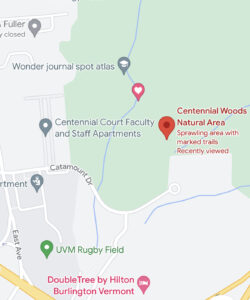Where: Centennial Woods, a short 15 minute walk from my dorm (that I have a feeling will feel less and less short as the snow accumulates) is the lovely location I selected to study for this assignment. Nestled between the Winooski River and the I-89 highway, Centennial is a surprisingly peaceful nature preserve that fosters a diverse and thriving ecosystem. 70 acres of woods, with the meandering “Centennial Brook,” and numerous trails snaking through the property, this forest is popular location for both UVM students and the public. For our purposes, this blog will focus on the specific changes of one plot along the brook. To find your way to this very special plot, you need only enter the woods from Catamount Drive and follow the main trail for about five minutes until you come to the first spot the brook and the trail (man-made wooden boardwalk at this point) run parallel with each other only 2 feet apart.
Why: With so many interesting and beautiful locations calling the Burlington area home, you may ask yourselves, “Why this one?” Well, the answer is that due to lack of transportation resources as a broke college freshman, Centennial Woods is a convenient walk from campus and one that is popular for other students phenology blogs. Seeing as I was already familiar with the area from NR1’s first lab this semester (and my friend was doing hers in Centennial too), I decided to take advantage of this and call the woods home for this phenology blog. As to why I chose this spot, all I can say is that I knew I wanted to study somewhere near the brook, because watching the waters freeze and then thaw again was something I wanted to document. This spot isn’t too deep in the woods so that it doesn’t involve excessive hiking through mountains of snow in the winter, and isn’t too close to the forest’s edge so that there is minimal noise pollution or evidence of anthropological activity.
What: As detailed above, this area’s center piece is Centennial Brook. The trail in this stretch consists of man made boardwalks to pass through the area avoiding trekking through the mud created by the brook. Headed deeper into the woods, the brook (shallow and rocky) is on your right and on the left is dense plant life. Similarly, the other side of the brook mirrors this plant life. Although the vegetation here is plentiful, it is showing signs of the coming winter such as withering. The most prominent species to be noted here are as follows; Goldenrod, Queen Anne’s Lace, Poison Ivy, Creeping Buttercup, and Glossy Buckthorn. Also, if you’re into trees, here you’ll find a Norway Maple, Green Ash, Northern Red Oak, and Eastern White Pine (if you squint high in the over story across the brook.) The above were identified with my clearly extensive knowledge of plants, and the help of friends and the NatureID app.

